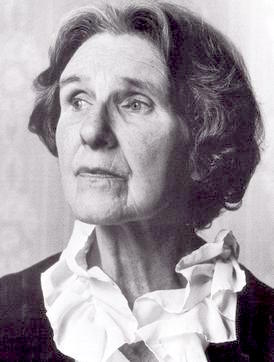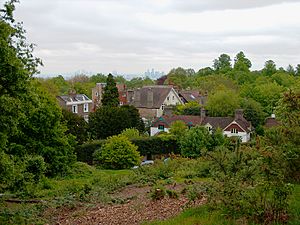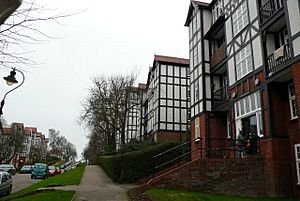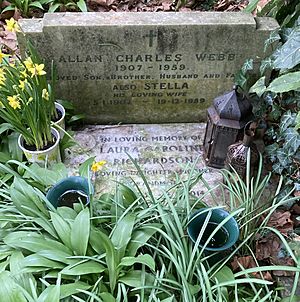Stella Gibbons facts for kids
Quick facts for kids
Stella Gibbons
|
|
|---|---|
 |
|
| Born | Stella Dorothea Gibbons 5 January 1902 London, England |
| Died | 19 December 1989 (aged 87) London, England |
| Occupation | Writer |
| Nationality | English |
| Period | 1930–70 |
Stella Dorothea Gibbons (born January 5, 1902 – died December 19, 1989) was an English writer, journalist, and poet. She became famous for her first novel, Cold Comfort Farm (1932). This book was printed many times. Even though she wrote for 50 years, none of her other 22 novels or poems became as popular. Many of her books were hard to find for a long time, but they became popular again in the 21st century.
Stella Gibbons was the daughter of a doctor in London. She had a difficult childhood. After school, she trained as a journalist. She worked as a reporter and writer for newspapers like the Evening Standard and The Lady. Her first book, published in 1930, was a collection of poems. It was well-liked. Stella always thought of herself as a poet first, not a novelist.
Cold Comfort Farm made fun of popular novels about country life. Most of Stella's other novels were about middle-class life in the suburbs, which she knew well. In 1950, she became a member of the Royal Society of Literature, an important writing group. Critics praised her writing for being charming, funny, and very descriptive. Some even compared her to Jane Austen. The huge success of Cold Comfort Farm shaped her career. She grew tired of being known only for that one book, and not for her other works. Many people thought she only wrote one good book. Some writers think this is because she stayed away from the main literary world and often made fun of it.
Stella Gibbons's Life Story
Early Life and Family
Stella Gibbons's family came from Ireland. Her grandfather, Charles Preston Gibbons, was an engineer who built bridges in South Africa. Stella's father, Telford Gibbons, became a doctor in 1897. In 1900, he married Maude Williams. They bought a house in Kentish Town, London, where Telford started his medical practice.
Stella was born on January 5, 1902. Her two brothers, Gerald and Lewis, were born later. Life in their home was often difficult because of Telford's bad temper. Stella later said her father was "a bad man, but a good doctor." He was kind to his poorer patients. But he made life hard for his family. Luckily, her mother was a calm and steady person. Stella was taught at home by governesses until she was 13. She loved reading and was good at telling stories to her younger brothers.
In 1915, Stella went to the North London Collegiate School in Camden Town. This school was one of the first in England to offer girls a good academic education. Stella found it hard to get used to the strict rules after being taught at home. She felt many rules were unfair. Another future writer, Stevie Smith, who joined the school in 1917, felt the same way. Stella was an average student in most subjects. But she was great at writing stories for her classmates. She was also a leader in the school's Debating Society.
University Days
While at school, Stella decided she wanted to be a writer. In 1921, she started a two-year journalism course at University College, London (UCL). This course was set up for soldiers returning from the First World War. But many women joined, including future novelist Elizabeth Bowen. The course covered many subjects like English Literature, economics, and history.
Stella loved university. It felt exciting after school. She made many friends, especially with Ida Affleck Graves, who also wanted to be a poet. They both loved books and had a similar sense of humor. Ida later said that many of their jokes ended up in Cold Comfort Farm. Stella's first published writing was a poem called "The Marshes of My Soul." It appeared in the University College Magazine in December 1921. Over the next two years, she wrote more poems and stories for the magazine. One story, "The Doer, a Story in the Russian Manner," showed hints of her later novels. Stella finished her course and got her diploma in 1923.
Working as a Journalist
Stella's first job was at the British United Press (BUP) news agency. She had to decode messages from other countries and rewrite them clearly. When things were quiet, she practiced writing articles, stories, and poems. She also traveled abroad for the first time, visiting France in 1924 and Switzerland in 1925. The Swiss mountains inspired some of her poems. In 1924, she met Walter Beck, who worked for his family's makeup company. They got engaged.
In May 1926, Stella's mother, Maude, died suddenly at age 48. Stella moved to new lodgings near Hampstead Heath. Five months later, on October 15, her father died from heart disease. Stella became the main provider for her family. Her youngest brother, Lewis, was still in school. Her older brother, Gerald, worked sometimes as an actor. The three of them moved into a small house on the Vale of Health, a village in the middle of Hampstead Heath. Famous writers like John Keats had lived there.
Later that year, Stella lost her job at BUP because of a mistake with money exchange rates. But she quickly found a new job as a secretary at the London Evening Standard newspaper. Soon, she was promoted to a reporter and features writer. She earned a good salary.
While working at the Evening Standard, Stella kept writing poetry. In September 1927, her poem "The Giraffes" was published in The Criterion, a literary magazine. The famous writer Virginia Woolf read and liked this poem. She asked Stella to write poems for her publishing company, the Hogarth Press. In January 1928, J. C. Squire, a well-known poet, started publishing Stella's poems in his magazine, The London Mercury. Squire also convinced Longmans to publish Stella's first collection of poems, The Mountain Beast, in 1930. It was well-received by critics. Stella's name appeared more and more often in the Standard. She interviewed famous people like Lillie Langtry. The newspaper also published some of Stella's short stories.
In August 1930, Stella was fired from the Standard. The paper said it was to save money. But Stella later thought it was because her relationship with Walter Beck was distracting her. Their engagement ended sadly in 1928. Stella wanted a serious relationship, but he wanted something more open. Her nephew and biographer, Reggie Oliver, believes Stella never fully got over Beck.
She quickly found a new job as an editor's assistant at The Lady magazine. Here, she wrote about almost everything except cooking. At the same time, she started writing her famous novel, Cold Comfort Farm. Her friend Elizabeth Coxhead said Stella "neglected her duties disgracefully" to work on this book.
Cold Comfort Farm
At The Lady magazine, Stella became known for her sharp book reviews. She was especially critical of popular "loam and lovechild" novels about country life. Writers like Mary Webb and Sheila Kaye-Smith were very popular for their stories about rural living. Stella thought their writing was too dramatic and their plots were silly. She decided her own first novel would be a funny parody of this style. By February 1932, she finished the book and sent it to her publishers, Longmans.
Stella first wanted to call her novel "Curse God Farm." But her friend Elizabeth Coxhead suggested "Cold Comfort," after a farm in Leicestershire. Stella loved the idea, and Cold Comfort Farm was published in September 1932. The story is about a smart, bossy London woman who tries to bring order to her messy country relatives, the Starkadders, on their run-down farm in Sussex. The book makes fun of writers like Thomas Hardy, Mary Webb, and D. H. Lawrence. It shows a funny picture of country life.
The book was an instant hit with both critics and the public. Stella made the satire even funnier by marking the most overly dramatic parts of the book with asterisks, "for the reader's delight and laughter." One critic found it hard to believe that such a clever parody was written by a little-known woman. He wondered if "Stella Gibbons" was a fake name for Evelyn Waugh. Stella suddenly became famous and was invited to many literary events. She didn't like being a celebrity. She got a literary agent who told her she could expect to earn a good living as a novelist. Because of this, she quit her job at The Lady at the end of 1932 to become a full-time writer.
In March 1931, Stella got engaged to Allan Webb, an actor and opera singer five years younger than her. They married on April 1, 1933. They had one daughter.
Later in 1933, Stella learned that Cold Comfort Farm had won the Prix Étranger. This was the foreign novel category of a famous French literary prize, the Prix Femina. She won against more experienced writers. This annoyed Virginia Woolf, who had also won the prize before. Today, only Cold Comfort Farm and Woolf's To the Lighthouse are remembered from those winners. And only Cold Comfort Farm gave us a famous phrase: "something nasty in the woodshed."
Becoming a Well-Known Author
The 1930s
During the rest of the 1930s, Stella wrote five more novels. She also published two poetry collections, a children's book, and many short stories. From November 1936, her family lived in Oakshott Avenue, on the Holly Lodge Estate in Highgate. Stella usually worked in the mornings. Her novels were generally well-liked, but none got as much attention as Cold Comfort Farm. Readers were told not to expect her second novel, Bassett (1934), to be like her first masterpiece.
Enbury Heath (1935) is a true story of her childhood and early adult life. Miss Linsey and Pa (1936) is thought to make fun of a famous lesbian novel from 1928. Stella's last novels before the war were Nightingale Wood (1935), which was like a modern Cinderella story, and My American (1939).
Stella always saw herself as a serious poet, not just a funny writer. She published two poetry collections in the 1930s. The Lowland Verses (1938) includes "The Marriage of the Machine," an early poem about the problems of industrial pollution. Stella's only children's book was The Untidy Gnome, published in 1935. She dedicated it to her only child, Laura, who was born that year.
War Years, 1939–1945
The start of Second World War in September 1939 did not stop Stella from writing. In November, she began writing "A Woman's Diary of the War" for St Martin's Review magazine. This series ran until November 1943. It included many of Stella's private thoughts about the war. In October 1941, she wrote that the war had helped her. She felt good about managing food rations and helping out. In July 1940, her husband Allan Webb joined the army. He later served overseas, mostly in Cairo.
Stella's 1940 collection, Christmas at Cold Comfort Farm, did not become as successful as the original. When it was reissued years later, it was called "comforting and amusing." Stella published three novels during the war: The Rich House (1941), Ticky (1942), and The Bachelor (1944). Ticky, which made fun of army life in the 1800s, was Stella's favorite novel. But she knew almost no one else liked it. It didn't sell well. One writer thought that the middle of World War II was not the right time to make fun of male aggression. The Bachelor was praised for showing life in war-torn Britain. Several of her later novels also did this.
After the War
Stella's first novel after the war was Westwood (1946). This book includes a funny picture of the novelist Charles Langbridge Morgan. Stella had reviewed his novel The Fountain before the war and found it "boring." In Westwood, Morgan appears as a pompous, humorless playwright. This character is one of Stella's "most enjoyable and mean" funny portraits. One writer described Westwood as a "rich, mature novel, romantic and wistful, full of rounded characters and terrific dialogue." It deserved more success.
But the public still mostly thought of Cold Comfort Farm. By 1949, it had sold many copies. Stella thought a sequel would be popular. So, that year, she wrote Conference at Cold Comfort Farm. It was her shortest novel. In this book, the farm has become a conference center and tourist spot. The book makes fun of modern art and ideas. Then the male Starkadders return from overseas, destroy the center, and make the farm wild again. The book was somewhat successful, but it was not as good as the original.
In 1950, Stella published her Collected Poems. In the same year, she became a Fellow of the Royal Society of Literature. Through the 1950s, she continued to write novels every two years or so. They were politely received, but none caused much excitement. One of these was Fort of the Bear (1953), which was set in the wild parts of Canada. This was her last book with Longmans. After that, her books were published by Hodder and Stoughton. A trip to Austria and Venice in 1953 gave her ideas for her novel The Shadow of a Sorcerer (1955). From 1954, Stella wrote often for Punch magazine for 15 years. One of her stories for Punch was "Jane in Space," written in the style of Jane Austen. Stella loved Jane Austen's writing.
After the war, Allan Webb continued his acting career. He had a brief affair with an actress, but Stella quickly forgave him. In 1949, he left the theater to work for a book club. Later, he bought a bookshop. His health got worse in the late 1950s, and he died in July 1959.
Later Years
After Allan's death, Stella stayed in her home and kept writing novels. From 1961, she rented a summer house in Trevone, Cornwall. This place became the setting for her 1962 novel The Weather at Tregulla. In 1965, she wrote an essay for a book about C.S. Lewis. In 1966, she wrote an essay for Punch called "Genesis of a Novel." In it, she thought about how Cold Comfort Farm affected her career. She compared the book to "some old uncle, to whom you have to be grateful because he makes you a handsome allowance, but is often an embarrassment and a bore."
Stella made her last trip abroad in 1966, to Grenoble, France. She visited her old friend Elizabeth Coxhead. This visit gave her ideas for her 1968 novel The Snow Woman. The Woods in Winter (1970) was her last published novel. She decided then that she no longer wanted editors to control her work. In the 1980s, she wrote two more novels just for her friends. These books, The Yellow Houses and An Alpha (later called Pure Juliet), were published in 2016.
Final Years
The last 20 years of Stella's life were quiet. She stayed healthy and beautiful almost until the end. She wrote occasional short stories, but the BBC rejected two of them. She also wrote three new poems for a 1986 book called Occasional Poets. These were her last published works. One of her poems, "Writ in Water," was inspired by her love for the poetry of Keats. In 2013, the original copy of this poem was given to the Keats-Shelley Memorial House museum in Rome.
Stella had many friends. In her later years, these included writer Richard Adams and entertainer Barry Humphries. From the mid-1970s, she held monthly tea parties at her home. She was known to ask guests to leave if they were too loud or dramatic. As she wrote less, she kept a notebook where she wrote her thoughts about literature. She was still writing in it in 1988.
From the mid-1980s, Stella had health problems. She started smoking again, which didn't help. In her last months, her grandson and his girlfriend cared for her at home. She died there on December 19, 1989, after collapsing the day before. She was buried in Highgate Cemetery next to her husband. At her funeral, her nephew and future biographer, Reggie Oliver, read two of her poems. One of them ended with these words: "Little is sure. Life is hard./We love, we suffer and die./But the beauty of the earth is real/And the Spirit is nigh."
Stella Gibbons's Writing Style
Style
Critics have praised Stella Gibbons's writing for being insightful, fun, charming, witty, and very descriptive. Her journalistic training helped her describe places and people well.
Some of Stella's poetry showed her love for nature. It also showed her early concern for environmental issues like sea pollution, long before these topics became popular.
List of Works
The publisher information is for the first publication only. Many of her books have been reissued by different publishers.
Novels
- Cold Comfort Farm. London: Longmans. 1932. OCLC 488370934.
- Bassett. London: Longmans. 1934. OCLC 1268745.
- Enbury Heath. London: Longmans. 1935. OCLC 771331617.
- Miss Linsey and Pa. London: Longmans. 1936. OCLC 771331622.
- Nightingale Wood. London: Longmans. 1938. OCLC 855282998. https://archive.org/details/in.ernet.dli.2015.474273.
- My American. London: Longmans. 1939. OCLC 3352997.
- The Rich House. London: Longmans. 1941. OCLC 4598606.
- Ticky. London: Longmans. 1943. OCLC 3349161.
- The Bachelor. London: Longmans. 1944. OCLC 3656831.
- Westwood, or The Gentle Powers. London: Longmans. 1946. OCLC 560579821.
- The Matchmaker. London: Longmans. 1949. OCLC 752953786.
- Conference at Cold Comfort Farm. London: Longmans 1949. OCLC 2550483.
- The Swiss Summer. London: Longmans. 1951. OCLC 3347559.
- Fort of the Bear. London: Longmans. 1953. OCLC 1268712.
- The Shadow of a Sorcerer. London: Hodder and Stoughton. 1955. OCLC 3298907.
- Here Be Dragons. London: Hodder and Stoughton. 1956. OCLC 3356228.
- White Sand and Grey Sand. London: Hodder and Stoughton. 1958. OCLC 4590193.
- A Pink Front Door. London: Hodder and Stoughton. 1959. OCLC 5755768.
- The Weather at Tregulla. London: Hodder and Stoughton. 1962. OCLC 3372249.
- The Wolves Were in the Sledge. London: Hodder and Stoughton. 1964. OCLC 5755731.
- The Charmers. London: Hodder and Stoughton. 1965. OCLC 560578870.
- Starlight. London: Hodder and Stoughton. 1967. OCLC 560579737.
- The Snow Woman. London: Hodder and Stoughton. 1968. ISBN 0-340-04264-8.
- The Woods in Winter. London: Hodder and Stoughton. 1970. ISBN 0-340-10570-4.
- Pure Juliet (formerly An Alpha ). London: Vintage Classics. 2016. ISBN 978-1-78487-027-0. https://archive.org/details/purejuliet0000gibb.
- The Yellow Houses. London: Vintage Classics. 2016. ISBN 978-1-78487-028-7.
Short Stories
- Roaring Tower and other stories. London: Longmans. 1937. OCLC 6705456.
- Christmas at Cold Comfort Farm and other stories. London: Longmans. 1940. OCLC 771331616.
- Beside the Pearly Water. London: Peter Nevill. 1954. OCLC 6922440.
Children's Books
- The Untidy Gnome. London: Longmans. 1935. OCLC 560579789.
Poetry
- The Mountain Beast. London: Longmans. 1930.
- The Priestess and other poems. London: Longmans. 1934. OCLC 7123475.
- The Lowland Venus. London: Longmans. 1938. OCLC 10421672.
- Collected Poems. London: Longmans. 1950. OCLC 3372203.
See also
 In Spanish: Stella Gibbons para niños
In Spanish: Stella Gibbons para niños





